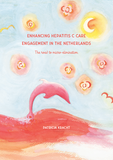Enhancing hepatitis C care engagement in the Netherlands
The road to micro-elimination

Kracht, Patricia
- Promoter:
- Prof.dr. A.I.M. (Andy) Hoepelman
- Co-promoter:
- Dr. J.E. (Joop) Arends
- Research group:
- Hoepelman
- Date:
- February 6, 2020
- Time:
- 12:45 h
Summary
In chapter 2, it was demonstrated that in 2016 several second-generation ribavirin-free DAA regimens achieved viral eradication in ≥95% in different type of patients other than those with prior NS5A-inhibitor exposure or decompensated cirrhosis. In chapter 3, various patient-reported outcomes (PROs) were prospectively evaluated before, during and after DAA treatment. Ribavirin use was the only independent predictor of the transient decline in the mental health-related quality of life (HRQL) that occurred at the end of treatment (EOT). Twelve weeks after the end of treatment (FU12), the HRQL had not changed compared to the baseline-levels. Through the REACH-project, described in chapter 4, 42 lost to follow-up (LFU) chronic HCV patients were re-evaluated by means of screening positive HCV diagnostics from the past 15 years. Retrieval was most feasible regionally since 28.3% of the patients eligible for retrieval from the Utrecht province were traced compared to 7.7% of those patients living outside the region. In 24% of the reevaluated patients, the liver fibrosis had progressed to an advanced stage (Metavir F3-F4). At follow-up, 59% of the traced patients had scheduled or initiated DAA therapy. Chapter 5 covers retrieval of chronic hepatitis B virus (HBV) patients. General practitioners (GPs) in Utrecht were asked to trace LFU chronic HBV patients and 49% returned a response that included either reevaluation outcomes or updated information on the patient’s follow-up status. Finally, 10% (N=62) of the eligible LFU chronic HBV patients was reevaluated of which 32% (N=20) was referred to a hospital. Reasons for previous loss to follow-up were explored in retrieved chronic HCV patients through in-depth interviews, characterized in chapter 6. A grounded theory based qualitative analysis uncovered ‘maintaining the achieved balance’ as the basic socio-psychological process in LFU HCV patients. The balance is steadfast state of mind in which patients marginalize having HCV. Patients arrived at this balance through a transformative process that followed the initial HCV diagnosis. Patients subsequently adopted evasive behavior in order to defend and preserve the achieved balance.
In chapter 7, strategies for achieving viral hepatitis C micro-elimination in the Netherlands were reviewed. Although many elimination endeavors were documented, the overview of the progress towards micro-elimination illustrates that no conclusions can be drawn until higher quality epidemiological data on the retention of patients in the HCV cascade of care is collected, with exception of the closely monitored HIV/HCV-coinfected population. The HCV in Addiction Care (HAC) quality improvement project (chapter 8) based on the Breakthrough methodology (i.e. Breakthrough project) implemented “good” or “sufficient” quality HCV healthcare pathways in 83% (N=10/12) of the participating addiction care units. Of all the identified chronic HCV infected clients 92% (N=70/76) was referred to a hepatitis treatment center. Uptake of HCV-screening (40% of all clients) and treatment after referral (39% of those referred) were identified as the main gaps to be closed in the HCV cascade of care in addiction care. Several best practices were identified including motivational counselling training, oral swabs for anti-HCV testing, facilitating complementary HCV RNA testing and supervised hospital visits.